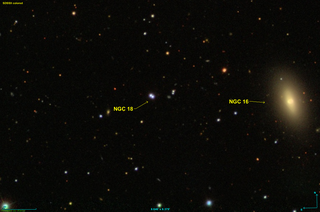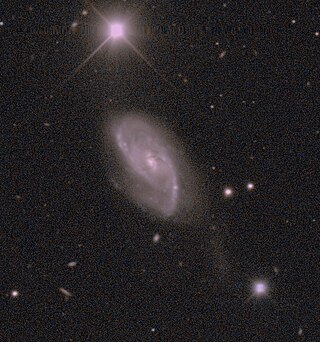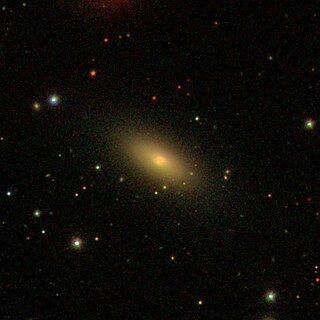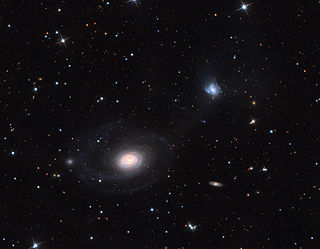Related Research Articles
NGC 6566 is a compact elliptical galaxy within the constellation Draco. It is located about 250 million light-years away from the Sun. It was discovered on October 27, 1861 by the astronomer Heinrich d'Arrest.

NGC 18 is a double star system located in the constellation of Pegasus. It was first recorded by Herman Schultz on 15 October 1866. It was looked for but not found by Édouard Stephan on 2 October 1882. It was independently observed by Guillaume Bigourdan in November 1886.

NGC 62 is a barred spiral galaxy in the constellation Cetus. NGC 62 is its New General Catalogue designation. It has an apparent magnitude of 13.2.

NGC 66 is a barred spiral galaxy discovered by Frank Muller in 1886, and is located in the Cetus constellation.

NGC 73 is an intermediate spiral galaxy estimated to be about 350 million light-years away in the constellation of Cetus. It was discovered by Lewis A. Swift from the USA in 1886 and its apparent magnitude is 13.7.

NGC 119 is an unbarred lenticular galaxy with an apparent magnitude of 13.0 located in the constellation Phoenix. It was discovered on October 28, 1834, by the astronomer John Herschel.

NGC 120 is a lenticular galaxy of type SB0? pec? with an apparent magnitude of 13.4 located in the constellation Cetus. It was discovered on 27 September 1880 by Wilhelm Tempel.

NGC 171 is a barred spiral galaxy with an apparent magnitude of 12, located around 200 million light-years away in the constellation Cetus. The galaxy has two main medium-wound arms, with a few minor arms, and a fairly bright nucleus and bulge. It was discovered on 20 October 1784 by William Herschel. It is also known as NGC 175.

NGC 523, also known as Arp 158, from the ARP catalog is a spiral galaxy located in the constellation Andromeda. It was discovered separately by William Herschel on 13 September 1784, and by Heinrich d'Arrest on 13 August 1862. d'Arrest's discovery was listed as NGC 523, while Herschel's was listed as NGC 537; the two are one and the same. John Dreyer noted in the New General Catalogue that NGC 523 is a double nebula.

NGC 521, also occasionally referred to as PGC 5190 or UGC 962, is a barred spiral galaxy located approximately 224 million light-years from the Solar System in the constellation Cetus. It was discovered on 8 October 1785 by astronomer William Herschel.

NGC 5575 is a lenticular galaxy in the constellation Virgo. The object was discovered on May 8, 1864 by the German astronomer Albert Marth.

NGC 5030 is a barred spiral galaxy in the constellation Virgo. The object was discovered on 17 March 1881 by the American astronomer Edward Singleton Holden.

NGC 4918 is a spiral galaxy in the constellation Virgo. The object was discovered in 1886 by the American astronomer Francis Preserved Leavenworth.

NGC 3545B is an elliptical galaxy in the constellation Ursa Major. The object is close to NGC 3545.

NGC 3402, also known as NGC 3411, is an elliptical galaxy in the constellation Hydra. The object was discovered on March 25, 1786 by German-British astronomer William Herschel. NGC 3402 is the largest galaxy in the eponymous NGC 3402 cluster.

NGC 528 is a lenticular galaxy located in the constellation Andromeda. It is located an estimated 70 million parsecs from the Milky Way. The object was discovered on 22 August 1865 by the German-Danish astronomer Heinrich Ludwig d'Arrest.

NGC 2460 is an unbarred spiral galaxy in the constellation Camelopardalis. It was discovered by German astronomer Wilhelm Tempel on August 11, 1882.

NGC 903 is a lenticular galaxy in the constellation Aries. It is estimated to be about 230 million light-years from the Milky Way and has a diameter of approximately 35,000 ly. NGC 903 was discovered on 13 December 1884 by the astronomer Edouard Stephan.

NGC 713 is a spiral galaxy located in the constellation of Cetus about 234 million light years from the Milky Way. It was discovered by the American astronomer Francis Leavenworth in 1886.
References
- 1 2 3 4 5 6 7 "NED results for object NGC 0191A". NASA/IPAC Extragalactic Database. National Aeronautics and Space Administration / Infrared Processing and Analysis Center . Retrieved 5 October 2018.
- 1 2 3 "2MASX J21174948-4823265". SIMBAD . Centre de données astronomiques de Strasbourg . Retrieved 13 October 2018.
- ↑ Seligman, Courtney. "New General Catalogue objects: NGC 7000 – 7049". cseligman.com. Retrieved 13 October 2018.